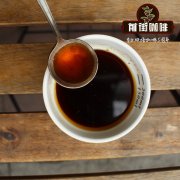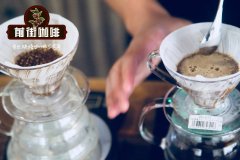How to make the perfect hand-made coffee at home? That's all you can do! Hand-made coffee course

Professional coffee knowledge exchange more coffee bean information please follow the coffee workshop (Wechat official account cafe_style)
New coffee machines are available year after year, especially this year! But can high-end equipment alone improve the quality of coffee? Not exactly! No matter what kind of device we use, if we don't understand how it brews, we will never be able to make really good coffee.
Today, let me give you an in-depth analysis of the working principle of the most popular hand coffee maker from the point of view of physics and chemistry.
To make hand-brewed coffee, you only need coffee powder, water, filter paper and coffee pot. To put it simply, the principle of making hand-brewed coffee is to manually pour water into the coffee powder to extract the essence. Although the principle seems simple, there are many difficulties in practice.
From the point of view of physics, the production of hand-brewed coffee is divided into the following three steps: wetting, dissolution and diffusion, which are closely related to each other and influence each other.
Why is coffee made by hand in a kettle different?
Unlike other brewing methods, hand-brewed coffee can continuously extract coffee powder with fresh water, so it is more efficient and faster to brew. But at the same time, because the water flows continuously, most of the extracted parts are concentrated on the surface of the coffee powder, which is like frying potatoes in a pan. If you stir-fry them quickly, the potatoes will ripen very quickly, but the surface will easily be scorched.
In addition, using a single water column (the outlet of the coffee machine is mostly shower-type, and multiple smaller columns of water flow out at the same time) will make the coffee hotter when brewing (multiple small columns of water will accelerate the temperature at the same time). This will also speed up the extraction rate of coffee.
About wetting
Wetting, as the name implies, is to soak dry coffee powder. This step is essential and crucial. You know, coffee produces a lot of carbon dioxide when it is roasted, especially lightly roasted coffee, which is still trapped in the bean structure and will slowly seep out over the next few weeks; deep-roasted coffee deflates faster.
When water comes into contact with coffee powder, carbon dioxide is instantly released, forming bubbles. The point is, if the carbon dioxide doesn't come out, the water can't get into the coffee powder. So at the beginning of brewing, soak the coffee powder with enough water and let it stand for 30 seconds to release as much carbon dioxide as possible so that the water can better extract the essence of the coffee later in the brewing process. Professionals often call this step "pre-brewing".
About dissolution
After the coffee powder is fully soaked and carbon dioxide is fully released, the water begins to dissolve the soluble substances in the coffee powder.
The real difficulty in making coffee is that coffee contains not only good soluble substances, but also bad taste soluble substances. Fortunately, good soluble substances dissolve faster, so what we need to do is to stop brewing at the right time to maximize the extraction of good soluble substances while avoiding the extraction of bad soluble substances.
About diffusion
Diffusion is the process in which water takes the soluble substance out of the coffee powder. Due to the higher concentration of the soluble substance in the cells inside the coffee powder, the solution will automatically flow from the higher concentration to the lower concentration. After this step, the extraction of coffee is complete.
About time and parameter adjustment
Nearly 2 of the substances in roasted coffee are insoluble, while only 1 of them is soluble, most of which are organic acids and sugars, and some long-chain molecules that form a bitter taste. After continuous research, it has been found that the optimal extraction level should be 19-20%, which means that if you extract 19-20% soluble substances from coffee, your coffee taste will be perfectly balanced. If the higher the degree of extraction, the coffee will become more bitter; if too low, the taste of coffee will tend to be insipid, lack of balance, the taste will be extremely sour. Therefore, time is the key to determining whether the taste of coffee is balanced.
In addition, we also need to pay attention to the degree of grinding of coffee powder. In general, the particle size of coffee powder is not uniform, and the extraction rate of those finer coffee powder is much faster than that of coarse coffee powder. in order to avoid this situation as much as possible, ensuring the quality of the bean grinder is the key.
To sum up, good hand-brewed coffee requires you to strictly control the grinding degree of coffee powder, brewing ratio (gouache ratio) and brewing time. The brewing rate depends on the degree of grinding of the coffee powder. The finer the coffee powder is ground, the slower the rate is, and vice versa. At the same time, the total amount of coffee (that is, the thickness of the powder bed) will also affect the extraction rate, thus it can be seen that there are many possible mistakes in making hand-brewed coffee!
Although you don't need too much professional brewing equipment to make hand-made coffee, the gooseneck pot is definitely a powerful helper to control the flow of water. The biggest difference between hand-brewing coffee and machine-brewing coffee is that you can see the whole process of brewing coffee, so better control of the speed and direction of the water means that you can extract the essence of coffee more fully and evenly.
We just mentioned that hand-brewed coffee will maintain a high temperature when brewing, and the pre-brewing process can effectively reduce the overall temperature of the coffee. You will rest for about 30 seconds during pre-brewing, when the coffee has enough time to cool. In order to avoid excessive extraction caused by high water temperature.
Having said that, let me teach you how to make the perfect hand-made coffee at home!
Before you start, be sure to prepare a timer, or you can use the timer that comes with your cell phone.
1. First of all, the degree of grinding of coffee powder should be like crude sugar (the feel of raw sugar).
With regard to the amount of powder, the best amount of most hand-brewed coffee pots should be 1 beat 2 to 2 beat 3 of the filter bowl. Too little, the flow of water will be too fast, difficult to control; too much, the flow of water will be too slow, or even overflow. My recommended moisture ratio is 60-70 grams of coffee powder with 1 liter of water (1:16-1:14).
two。 Prepare pure hot water. The water should stand for 30 seconds before starting to brew, and the temperature should be about 207℉ (97 ℃).
3. Start the clock, soak all the coffee powder with enough hot water and let it stand for 30 seconds before starting to brew.
4. Pour water. Pour water as evenly and gently as possible, which can be divided into several times to ensure the overall brewing time. The height of pouring water will directly affect the water temperature. In order to avoid excessive temperature loss, water should be poured as low as possible.
After stopping pouring water, the coffee will be extracted for another 20-60 seconds.
With regard to the overall brewing time of coffee, deep-roasted coffee should be 2.5-3 minutes, medium-and light-roasted coffee should be 3-4 minutes, including the extraction time after stopping pouring water.
Finally, you should adjust the above parameters according to the taste of the coffee. If the coffee is too light, try to grind it finer next time; if it is too strong, try to grind it thicker.
Important Notice :
前街咖啡 FrontStreet Coffee has moved to new addredd:
FrontStreet Coffee Address: 315,Donghua East Road,GuangZhou
Tel:020 38364473
- Prev

How did hand-brewed coffee rise Melita filter cup who invented the history of hand-brewed coffee
Professional coffee knowledge exchange More coffee bean information Please pay attention to coffee workshop (Weixin Official Accounts cafe_style) With the sweep of the third wave of coffee, fine coffee has become the mainstream of the global coffee industry, and the most shining treasure is hand-brewed coffee. Except for the coffee shops that specialize in hand brewed coffee, a large number of coffee shops appear. Because hand brewed coffee is very personal,
- Next

4 the skill of making coffee with big hands, making coffee by yourself can make people and gods indignant.
Professional coffee knowledge exchange more coffee bean information please follow the coffee workshop (Wechat official account cafe_style) Taiwanese love to drink coffee, but also like to brew their own coffee, the rise of hand-brewed coffee has led to a trend of brewing their own coffee, and even utensils are constantly innovating, giving coffee fans more choices; hand-brewed coffee classrooms or coffee clubs have also been set up one by one, which can be seen
Related
- Beginners will see the "Coffee pull flower" guide!
- What is the difference between ice blog purified milk and ordinary milk coffee?
- Why is the Philippines the largest producer of crops in Liberia?
- For coffee extraction, should the fine powder be retained?
- How does extracted espresso fill pressed powder? How much strength does it take to press the powder?
- How to make jasmine cold extract coffee? Is the jasmine + latte good?
- Will this little toy really make the coffee taste better? How does Lily Drip affect coffee extraction?
- Will the action of slapping the filter cup also affect coffee extraction?
- What's the difference between powder-to-water ratio and powder-to-liquid ratio?
- What is the Ethiopian local species? What does it have to do with Heirloom native species?

